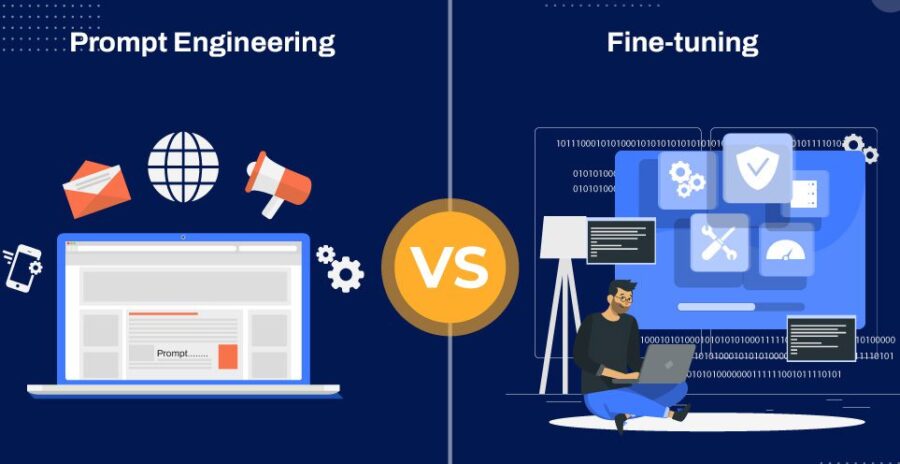
How AI Development Services Train Machine Learning Models
June 4, 2025
AI Content Generation: From Headlines to Hashtags
June 5, 2025Introduction to Prompt Engineering
Prompt engineering is the strategic art and science of crafting inputs to effectively guide language models like GPT-4 to produce desired outputs. As Artificial Intelligence continues to transform industries, prompt engineering has become an essential skill for maximizing the capabilities of AI-driven systems, particularly in areas like content creation, AI marketing, and B2B lead generation.
Evolution of Prompt Engineering
The journey of prompt engineering began with basic natural language processing (NLP) commands. With the introduction of large language models (LLMs), the sophistication of prompts evolved significantly. Today, prompt engineering is not just a technique but a recognized field of study that influences how businesses leverage Artificial Intelligence for tasks ranging from customer service automation to generating B2B leads through AI marketing campaigns.

How Prompt Engineering Works
A well-crafted prompt is the foundation of effective AI output. Prompts can be zero-shot (no examples), one-shot (a single example), or few-shot (multiple examples), each influencing how the AI interprets tasks. Prompt tuning involves fine-grained control over responses, while prompt design focuses on the creative structuring of input to optimize results. These strategies are vital when deploying AI tools for scalable content marketing and lead generation in B2B contexts.

Role in AI Content Generation
Prompt engineering plays a central role in generating high-quality, coherent, and relevant content. In the context of AI marketing, it can automate blog writing, social media posts, email campaigns, and whitepapers. By using prompt engineering, marketers can enhance brand messaging and generate more qualified B2B leads through persuasive, AI-generated content.
Best Practices in Prompt Engineering
Effective prompt engineering starts with clarity and specificity. Good prompts provide context, use structured language, and are iteratively refined based on results. For instance, when creating content for AI marketing campaigns, framing the prompt with the target audience in mind (e.g., B2B executives) ensures higher relevance. Constraints such as tone, format, and style can also guide the AI to generate more tailored results.

Tools and Platforms Supporting Prompt Engineering
Several tools support prompt engineering. OpenAI Playground is a foundational platform for experimenting with prompt structures. More advanced tools like LangChain and PromptLayer offer infrastructure for managing and scaling prompt workflows. These tools are invaluable for content strategists seeking to scale AI-driven initiatives and generate consistent B2B leads.

Challenges in Prompt Engineering
While powerful, prompt engineering isn’t without challenges. The flexibility of human language introduces ambiguity, making output prediction difficult. Prompt sensitivity, where small changes yield different outputs, complicates consistency. Especially in AI marketing, ensuring brand alignment and factual accuracy in AI-generated content requires a careful balance between creativity and control.
Ethical and Societal Implications
Prompt engineering must be approached with ethical caution. Poorly designed prompts can unintentionally amplify bias, misinformation, or harmful stereotypes. Responsible prompt engineering considers inclusivity, fairness, and transparency, especially when used in large-scale marketing or decision-making processes that impact real users.
Prompt Engineering for Different Content Types
Different content formats benefit from specialized prompt designs. Educational content needs instructional prompts; technical writing requires precision and data emphasis; while conversational AI relies on prompts that maintain tone and context. For AI marketing, prompts should reflect brand voice and audience intent, whether generating content for blog posts or converting B2B leads through targeted email campaigns.
Advanced Techniques in Prompt Engineering
Advanced methods like chain-of-thought prompting allow the AI to “think” step-by-step before answering, resulting in more logical outputs. Persona-based prompting lets the AI adopt specific roles (e.g., “You are a B2B marketing strategist”), enhancing relevance. These techniques are especially useful in AI marketing, where nuanced understanding of the target demographic is key to lead generation.

Prompt Engineering and Fine-Tuning
While prompt engineering tailors responses at runtime, fine-tuning involves training the model with additional data for long-term behavior adjustment. In B2B lead generation workflows, prompt engineering is often quicker and more cost-effective, though hybrid approaches that combine fine-tuned models with dynamic prompts are becoming increasingly popular.
The Role of Feedback Loops
Feedback is vital for optimizing prompt performance. Human-in-the-loop systems help refine AI responses in real-time, while Reinforcement Learning with Human Feedback (RLHF) ensures that the AI aligns with business goals. For B2B marketers, using performance metrics from email click-throughs or content engagement can help improve prompt structures over time.
Measuring Prompt Performance
Prompt effectiveness can be evaluated through qualitative and quantitative metrics. A/B testing with variations of prompts helps identify what resonates best. For example, testing different prompts for AI-generated LinkedIn posts can reveal what generates the most engagement or conversions in a B2B context.
The Future of Prompt Engineering
The future of prompt engineering lies in automation, community sharing, and integration with ethical AI practices. Platforms are emerging where users can share successful prompts, much like code snippets. As regulatory frameworks around Artificial Intelligence solidify, prompt engineering will play a pivotal role in ensuring AI systems are not only effective but also accountable and fair.
Conclusion
Prompt engineering is a cornerstone of modern AI applications, especially in content generation, AI marketing, and lead generation. By mastering the art of prompt design, businesses can unlock the full potential of Artificial Intelligence to scale personalized content, engage target audiences, and generate quality B2B leads. As the field evolves, continuous experimentation, ethical consideration, and collaboration will shape the next era of AI content innovation.


